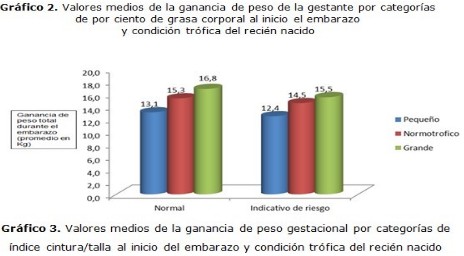Maternal anthropometry and trophic condition of the newborn
Keywords:
Composición corporal, estado nutricional de la embarazada. Índice de masa corporal, distribución regional del tejido adiposo.Abstract
Background: the nutritional state of a pregnant when she begins being followed up, her body fat and weight gains during pregnancy can affect growing and fetal development in mother’s health.
Objective: to determine the possible relation of the pregnant‘s nutritional state at follow up, the body fat, and weight gains during pregnancy with trophic condition of the new-born.
Methods: a prospective longitudinal study was conducted in 582 pregnant women from “Chiqui Gómez Lubián” health center in Santa Clara municipality. Specific anthropometric methods were applied to determine the body mass index, the percentage of body fat and weight gains for trimesters during pregnancy, as well as to evaluate the trophic condition of the new-born. Distributions of frequencies and analyses of variable association were carried out.
Results: the association of nutritional state with body fat percentage and waist/ height index, as in waist height index with body fat percentage. Pregnant women with adequate weight and normal percentages of body weight and waist/height prevailed. The greatest weight gains during pregnancy corresponded to mothers of big children for the gestational age.
Conclusions: the nutritional state of the pregnant at the beginning of the pregnancy seems to mask the real proportions of body fat and particularly abdominal adiposity, according to the figures of body mass index. However, waist/height index can reveal in time the behavior of composition and distribution of fat in the woman from the beginning of the pregnancy. The greatest weight gains occurred in those pregnancies with big new-borns for the gestational age, in dependence of the nutritional state when they were followed-up.
DeCS: ANTHROPOMETRY; BODY COMPOSITION; NUTRITIONAL STATUS; BODY MASS INDEX; LONGITUDINAL STUDIES.
Downloads

Published
How to Cite
Issue
Section
License
Copyright: Camagüey Medical Archive Magazine, offers immediately after being indexed in the SciELO Project; Open access to the full text of the articles under the principle of making available and free the research to promote the exchange of global knowledge and contribute to a greater extension, publication, evaluation and extensive use of the articles that can be used without purpose As long as reference is made to the primary source.
Conflicts of interest: authors must declare in a mandatory manner the presence or not of conflicts of interest in relation to the investigation presented.
(Download Statement of potential conflicts of interest)
The Revista Archivo Médico de Camagüey is under a License Creative Commons Attribution-Noncommercial-No Derivative Works 4.0 International (CC BY 4.0).
This license allows others to distribute, to mix, to adjust and to build from its work, even for commercial purposes, as long as it is recognized the authorship of the original creation. This is the most helpful license offered. Recommended for maximum dissemination and use of licensed materials. The full license can be found at: https://creativecommons.org/licenses/












 22 julio 2025
22 julio 2025